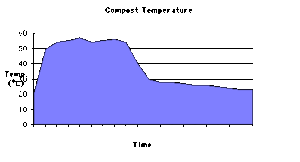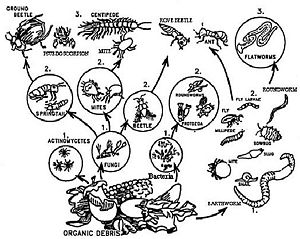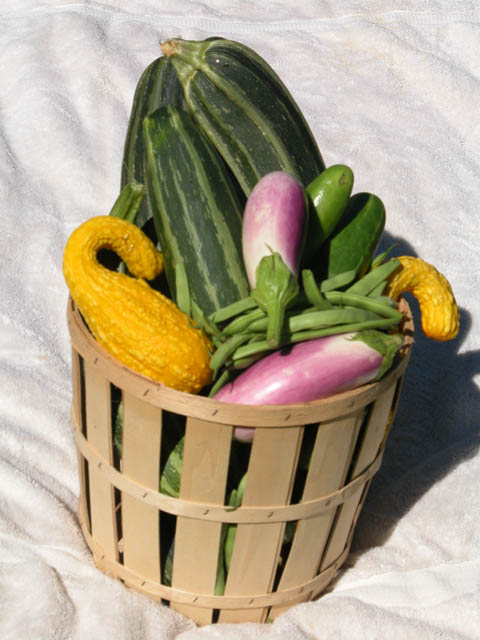Compost pile: Difference between revisions
| Line 12: | Line 12: | ||
''Pseudomonas stutzeri '' | ''Pseudomonas stutzeri '' | ||
Gram-negative, rod-shaped, motile, single polar-flagellated, soil bacterium first isolated from human spinal fluid.<sup>3</sup> | Gram-negative, rod-shaped, motile, single polar-flagellated, soil bacterium first isolated from human spinal fluid.<sup>3</sup> | ||
''Pseudomonas stutzeri '' is not fluorescent like other members of genus Pseudomonas and are denitrifying bacterium. | Strain KC of P. stutzeri could be used for bioremediation as it can degrade carbon tetrachloride.<sup>4</sup>''Pseudomonas stutzeri '' is not fluorescent like other members of genus Pseudomonas and are denitrifying bacterium.In spite of marked differences from the type strain of the genus, the sequence similarities of the rRNAs, demonstrated initially by DNA-rRNA hybridization, show the legitimacy of the inclusion of P. stutzeri in the genus Pseudomonas. Strains of the species have been identified among denitrifiers found in natural materials. Related species within the genus, such as P. ''mendocina'', P. ''alcaligenes'',P. ''pseudoalcaligenes'', and P. ''balearica''.<sup>5</sup> | ||
==Compost Temperature== | ==Compost Temperature== | ||
Revision as of 04:28, 29 August 2008
Introduction
Compost is decomposition of Organic Matter such as kitchen scraps, wood shavings, yard trimmings, paper and cardboard. Compost supplies nutrients and advantageous life to the soil, develops better soil structure, and helps prevent overflow that can contaminate water streams such as rivers and lakes. Compost helps the soil soak up and preserve nutrients and provides plants protection from pests and diseases. Moreover, compost provides moisture which means less watering where you can conserve water and prevent river or lake pollution. Compost introduces and feeds diverse life in the soil, including bacteria, insects, worms, and more, which support vigorous, plant growth. Compost pile also helps yard protection during rainstorm. An excess of nutrients in water can deplete the oxygen available to fish and other aquatic life.1
Figure shows As you can see bacteria, fungi, and other microbes, these organisms make up a complex food web or energy pyramid with primary, secondary, and tertiary level consumers. The base of the pyramid, or energy source, is made up of organic matter including plant and animal residues. Organic residues such leaves or other plant materials are eaten by some types of invertebrates such as millipedes, sow bugs, snails and slugs. These invertebrates shred the plant materials, creating more surface area for action by fungi, bacteria, and actinomycetes (a group of organisms intermediate between bacteria and true fungi), which are in turn eaten by organisms such as mites and springtails.2
Description of Niche
Thermus Highest compost temperatures, bacteria of the genus Thermus. Gram-negative bacteria likes ideal growth temperature of between 70°C and 75 °C with pH range between 7.5 to 8.0.
Pseudomonas stutzeri Gram-negative, rod-shaped, motile, single polar-flagellated, soil bacterium first isolated from human spinal fluid.3 Strain KC of P. stutzeri could be used for bioremediation as it can degrade carbon tetrachloride.4Pseudomonas stutzeri is not fluorescent like other members of genus Pseudomonas and are denitrifying bacterium.In spite of marked differences from the type strain of the genus, the sequence similarities of the rRNAs, demonstrated initially by DNA-rRNA hybridization, show the legitimacy of the inclusion of P. stutzeri in the genus Pseudomonas. Strains of the species have been identified among denitrifiers found in natural materials. Related species within the genus, such as P. mendocina, P. alcaligenes,P. pseudoalcaligenes, and P. balearica.5
Compost Temperature
In the process of composting, microorganisms shatter down organic matter by producing carbon dioxide, water, heat, and humus. Under optimal conditions, composting proceeds through three phases: 1) the mesophilic, or moderate-temperature phase, which lasts for a couple of days, 2) the thermophilic, or high-temperature phase, which can last from a few days to several months, and finally, 3) a several-month cooling and maturation phase.
Figure 2 Different communities of microorganisms predominate during the various composting phases. Starting decomposition carried by mesophilic microorganisms, which rapidly break down the soluble, readily degradable compounds. Temperature rises above 40°C, the mesophilic microorganisms become less competitive and are replaced by others that are thermophilic, or heat-loving. At temperatures of 55°C and above, many microorganisms that are human or plant pathogens are destroyed. High temperatures accelerate the breakdown of proteins, fats, and complex carbohydrates like cellulose and hemicelluloses, the major structural molecules in plants. Over 65°C kill many forms of microbes and limit the rate of decomposition, compost managers use aeration and mixing to keep the temperature below this point. Final phase of "curing" or maturation of the remaining organic matter.2
Who lives there?
Actinomycetes- fungi resembled bacteria with filamentous. Fungi those are resistant to dry, acidic, or low in nitrogen for bacterial decomposition environment. Most fungi are classified as saprophytes because they live on dead or dying material and obtain energy by breaking down organic matter in dead plants and animals. Fungal species are numerous during both mesophilic and thermophilic phases of composting. Most fungi live in the outer layer of compost when temperatures are high. Compost molds are strict aerobes that grow both as unseen filaments and as gray or white fuzzy colonies on the compost surface. Protozoa are one-celled microscopic animals. They are found in water droplets in compost but play a relatively minor role in decomposition. Protozoa obtain their food from organic matter in the same way as bacteria do but also act as secondary consumers ingesting bacteria and fungi. Rotifers Rotifers are microscopic multicellular organisms also found in films of water in the compost. They feed on organic matter and also ingest bacteria and fungi. Nematodes: Bacteria and fungal feeding Nematodes are very important in the soil foodweb for cycling nutrients for the plants. At Mother Nature's Farms we are taking special steps to develop healthy populations of these beneficial nematodes in our finished products, to optimize finished product quality. ANTS ants can make compost richer in phosphorus and potassium by moving minerals from one place to another.
Do the microbes that are present interact with each other?
Describe any negative (competition) or positive (symbiosis) behavior
Do the microbes change their environment?
Do they alter pH, attach to surfaces, secrete anything, etc. etc.
Do the microbes carry out any metabolism that affects their environment?
Do they ferment sugars to produce acid, break down large molecules, fix nitrogen, etc. etc.
Current Research
microbes can strip out the oxygen in compost, within 15 minutes, there must be a constant flow of air through the compost, and far more than provided by passive aeration by convection Mother Natures Farm (Magic soil) is located in New york and they are currently working on three compost research silos that are specially modified for capturing the Surplus Microbial Metabolic Heat from early stage compost. Using compost (magic soil) and growing healthly organic food. "We expect to massively expand our Research growing, because demand for finished compost is totally dependant upon how well plants thrive in the finished product." Pathogens like E-Coli 0157 can easily be killed by the high temperatures easily achieved in well managed composting. How Much Air is Required to hold the CO2 level down to 2%? (oxygen level about 19%) Mother Nature are currently researching on how to get 200 times more fungal density than “normal” in the industry; enabling us to significantly speed up the composting process.
Acknowledgment
Thanks to Mr. John A. Crockett for sharing very informative information on Magic bio Soil(Mother Nature’s Farms, Inc). Their mission is to convert organic wastes into high quality soils and soil conditioners for all those involved in growing plants, landscapers, homeowners, and nurseries. We are committed to being a very good neighbor in the process, earning neighbor and community respect and support, not just tolerance. We will continue to do research in the areas of process and end product enhancement. As you can see the outcome of composting he was able to produce healthy food.
References
[1]Michaelides, Adam. Compost Education Program . 31 Dec 2007. 21 Aug 2008 <http://counties.cce.cornell.edu/tompkins/compost/Basics%20&%20Bennefits%20of%20Composting.pdf>.
[2]Olynciw, Nancy Trautmann and Elaina. Compost Microorganisms. 1995. 21 Aug 2008 <http://compost.css.cornell.edu/microorg.html>.
[3]Sijderius, R. "Heterotrophe bacterien, die thiosulfaat oxydeeren." Thesis, University Amsterdam, 1946, pp. 1-146
[4]Sepulveda-Torres, et al. (1999). "Generation and initial characterization of Pseudomonas stutzeri KC mutants with impaired ability to degrade carbon tetrachloride". Arch Microbiol 171 (6): 424–9. <http://www.ncbi.nlm.nih.gov/pubmed/10369898>.
[5]Jorge Lalucat, Antoni Bennasar, Rafael Bosch, Elena Garcı´a-Valde´s, and Norberto J. Palleroni. "Biology of Pseudomonas stutzeri." MICROBIOLOGY AND MOLECULAR BIOLOGY (2006): 510-547.<http://mmbr.asm.org/cgi/reprint/70/2/510>.
Edited by [Natasha Naidu], students of Rachel Larsen




